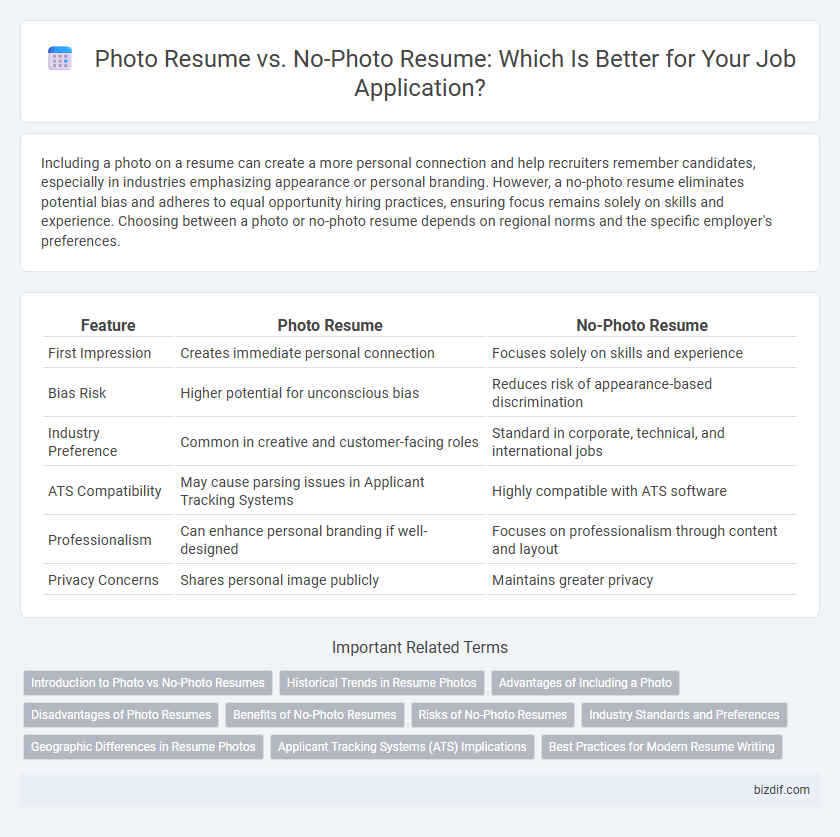Including a photo on a resume can create a more personal connection and help recruiters remember candidates, especially in industries emphasizing appearance or personal branding. However, a no-photo resume eliminates potential bias and adheres to equal opportunity hiring practices, ensuring focus remains solely on skills and experience. Choosing between a photo or no-photo resume depends on regional norms and the specific employer's preferences.
Table of Comparison
| Feature | Photo Resume | No-Photo Resume |
|---|---|---|
| First Impression | Creates immediate personal connection | Focuses solely on skills and experience |
| Bias Risk | Higher potential for unconscious bias | Reduces risk of appearance-based discrimination |
| Industry Preference | Common in creative and customer-facing roles | Standard in corporate, technical, and international jobs |
| ATS Compatibility | May cause parsing issues in Applicant Tracking Systems | Highly compatible with ATS software |
| Professionalism | Can enhance personal branding if well-designed | Focuses on professionalism through content and layout |
| Privacy Concerns | Shares personal image publicly | Maintains greater privacy |
Introduction to Photo vs No-Photo Resumes
Photo resumes include a candidate's picture alongside their professional information, offering recruiters visual context that can enhance memory recall and personalization. No-photo resumes prioritize textual content, emphasizing skills, experience, and qualifications without potential biases linked to appearance. Selecting between photo and no-photo resumes depends on industry norms, cultural expectations, and the goal to balance professionalism with individuality.
Historical Trends in Resume Photos
Resume photos have experienced fluctuating popularity, with early 20th-century resumes commonly featuring headshots to personalize applications. During the late 20th century, many Western countries moved away from photo resumes to reduce bias and discrimination in hiring processes. Recent trends indicate a resurgence in some industries where visual presentation and personal branding are valued, though many companies maintain strict policies against photos to promote fairness.
Advantages of Including a Photo
Including a photo in a resume enhances personal branding by creating a memorable first impression and fostering trust with potential employers. Visual elements increase engagement, making the resume stand out in applicant tracking systems and manual reviews. In industries like marketing, sales, and hospitality, a professional photo can convey approachability and cultural fit more effectively than text alone.
Disadvantages of Photo Resumes
Photo resumes can lead to unconscious bias and discrimination based on appearance, which may affect hiring decisions unfairly. Including a photo also risks violating privacy or creating legal issues related to equal employment opportunity laws. Some employers prefer no-photo resumes to focus solely on skills and experience, maintaining a more objective evaluation process.
Benefits of No-Photo Resumes
No-photo resumes eliminate potential biases related to age, gender, ethnicity, or appearance, promoting fairer hiring decisions based solely on qualifications and experience. They support applicant privacy and reduce the risk of discrimination, aligning with equal employment opportunity practices. Many employers prefer no-photo resumes as they streamline candidate evaluation and focus attention on relevant skills and achievements.
Risks of No-Photo Resumes
No-photo resumes may face higher risks of being overlooked by recruiters who rely on visual cues to quickly identify candidates. Without a photo, applicants might experience reduced memorability and weaker personal branding compared to photo resumes. This can result in fewer interview invitations, particularly in industries valuing personal image and presence.
Industry Standards and Preferences
Photo resumes are commonly preferred in industries like modeling, acting, and hospitality where visual appearance plays a crucial role in hiring decisions. In contrast, sectors such as finance, law, and tech prioritize no-photo resumes to emphasize skills and qualifications while minimizing unconscious bias. Adhering to industry standards by including or excluding a photo can significantly impact resume effectiveness and recruiter reception.
Geographic Differences in Resume Photos
Resume photo inclusion varies significantly by geography, with countries like Germany, Japan, and South Korea commonly expecting photos on CVs, while the United States, United Kingdom, and Canada often discourage them to avoid bias. European employers frequently view photos as a means to personalize applications, whereas North American hiring practices emphasize anonymized resumes to promote diversity and reduce discrimination. Understanding these regional preferences is crucial for tailoring resumes to specific job markets and enhancing candidate competitiveness.
Applicant Tracking Systems (ATS) Implications
Including a photo on a resume can negatively impact its compatibility with Applicant Tracking Systems (ATS), as many ATS software are designed to parse and prioritize text rather than images. A no-photo resume ensures that critical information like contact details, skills, and experience are easily extracted and ranked by ATS algorithms, increasing the chances of passing initial screenings. Employers relying heavily on ATS prefer resumes that are clean, text-focused, and formatted to enhance keyword recognition and data extraction accuracy.
Best Practices for Modern Resume Writing
Including a professional photo on a resume can personalize your application and make a memorable first impression, especially in creative industries or regions where photos are customary. However, in many global markets like the United States and United Kingdom, omitting a photo is preferred to avoid unconscious bias and maintain focus on qualifications and experience. Best practices for modern resume writing emphasize tailoring the presence or absence of a photo according to industry norms, legal considerations, and the cultural expectations of the potential employer.
Photo Resume vs No-Photo Resume Infographic

 bizdif.com
bizdif.com